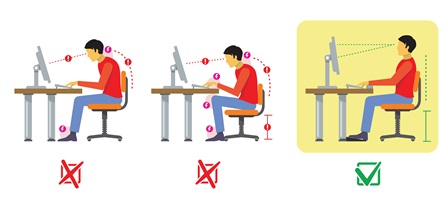DSE stands for Display Screen Equipment – the term originally referred to computer screens and laptops but now encompasses tablets, Smartphones, iPads, and touchscreens which have a graphic or alphanumeric image. [i]
If you use DSE daily for an hour or more at a time, you qualify as a DSE user. If you are an employer of DSE users, you have an obligation to comply with The Health and Safety (Display Screen Equipment) Regulations 1992. [ii]
The regulations were put in place by the Health & Safety Executive (HSE) to reduce risks from prolonged DSE use:
Incorrect use of DSE or poorly designed workstations or work environments can lead to pains in neck, shoulders, backs, arms, wrists and hands as well as fatigue and eye strain. The causes may not always be obvious. [iii]
What is a DSE Assessment?
The main objective of a DSE Assessment is to ensure that a person’s workstation is set up for them to achieve the best possible posture whilst carrying out necessary tasks, while minimising strain on the body to reduce risks of pain or injury (e.g. repetitive strain) and lessen fatigue.
Educating employers and employees on best practice for DSE is an important part of the assessment, to highlight the risks and to promote wellbeing and productivity. For example, you may know that the HSE recommends taking regular breaks, but do you know why? As well as mentally helping you to re-focus on a task, taking a break reduces the detrimental effects of sitting for long periods; which can restrict blood supply, reduce circulation, cause discomfort and fatigue. These are just some of the reasons why taking a break is good for you!
What happens at a DSE Assessment?
After initial observations of the workstation, the assessor goes through a sequence of checks that are methodical by nature, to ensure that the assessment is effective and thorough. As well as evaluating obvious factors such as the chair, desk, and DSE user’s posture, the assessor looks at environmental factors (heating, lighting etc) to judge their impact too.
Necessary adjustments and recommendations for best practice are then explained to the user. Education is important here because adjusting to new habits can take time and effort – knowing the reasons for change can help the user adapt. Involving the DSE user in all stages, ensures the assessment is specifically tailored to each individual.
Why are DSE Assessments important?
Even minor adjustments can make a huge difference and can reduce or eliminate stress or strain on the body for the DSE user.
It’s important to understand that reducing risks and improving ‘working’ posture, can have a significant impact on wellbeing and productivity. Furthermore, “prevention is better than cure”.
Far better to invest in DSE assessments and appropriate workstations that safeguard employee wellbeing, than to be faced with absenteeism due to musculoskeletal pain (pain in muscle or spine) or RSI (repetitive strain injury) [iv]. Wouldn’t you agree?
What to do now?
Take a moment to think about how you currently sit at your desk:
- Do you tend to raise your shoulders in order to use the keyboard?
- Are your shoulders hunched over or forward?
- Is your chin jutting forward to look at the screen?
- Can you recognise some of the ‘bad’ postures in the diagram above?
Knowing that you’ve started to adopt poor posture as a DSE user is a start. Taking action to get assessed is the next step because as you’ve probably just realised, making an objective assessment of your own posture is very difficult to do.
For further advice and information on DSE regulations and assessments please refer to the links below.
https://www.essentialvitality.co.uk/display-screen-equipment-assessments/
http://www.hse.gov.uk/msd/dse/index.htm
https://www.ergonomics.org.uk/
[i] http://www.hse.gov.uk/pubns/indg36.pdf
[ii] http://www.hse.gov.uk/pUbns/priced/l26.pdf




